Happy fall garden
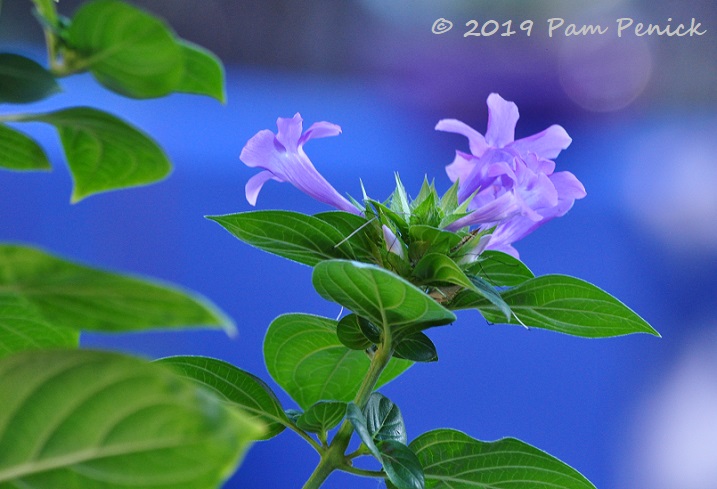
With the Death Star at bay and a little rain last week, the plants are rejoicing with a flush of flowers. It’s a second spring for us Texas gardeners.
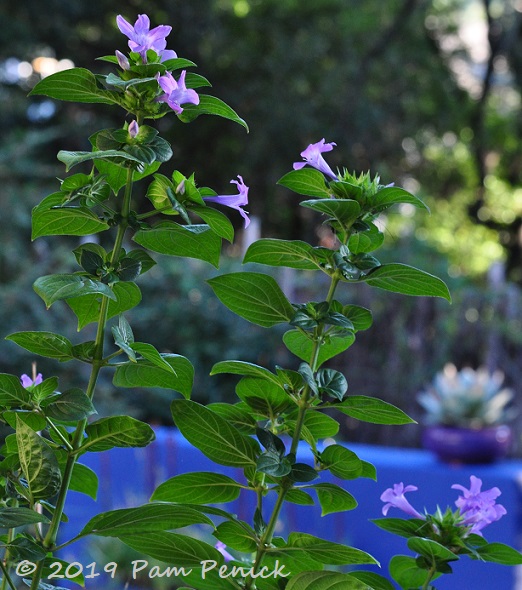
Being mostly shady, my garden isn’t exactly a flower-lover’s paradise. It’s all about foliage and texture and, frankly, in the front yard, whatever the deer won’t eat. So I especially love it when flowers do appear, like these lavender lovelies on Philippine violet (Barleria cristata).
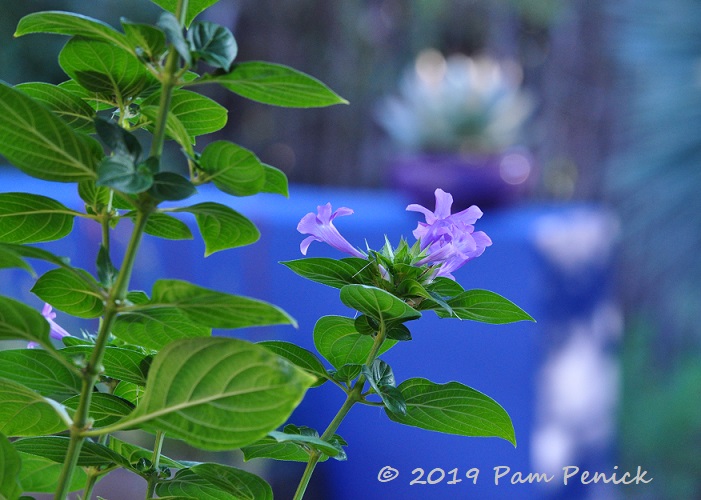
Purple, cobalt blue, and green, one of my favorite color combos.
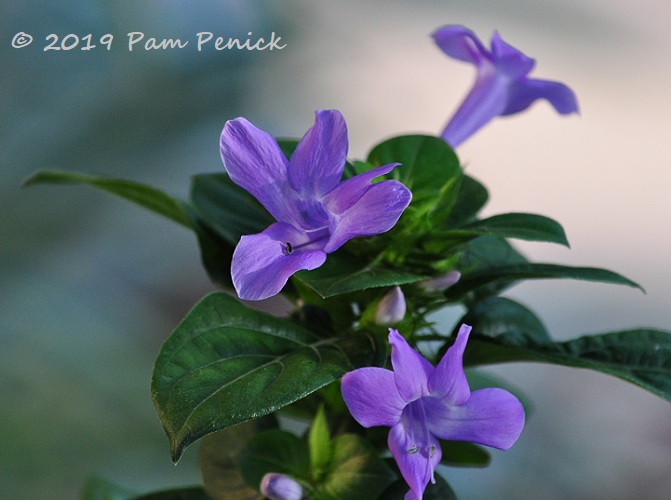
Philippine violet and I both love fall.
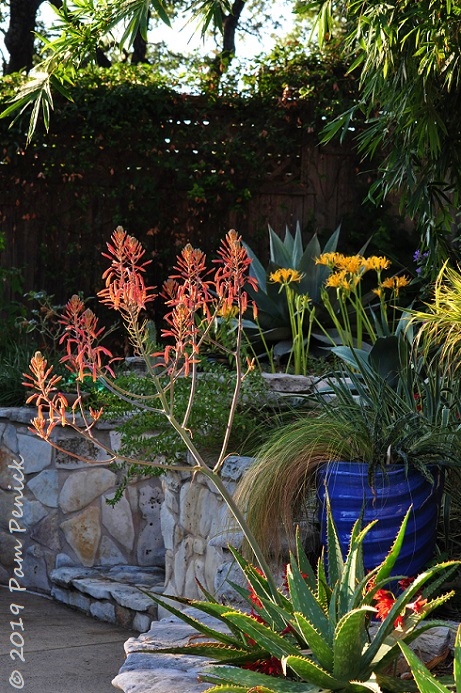
One of the soap aloes (Aloe maculata) has hoisted a candelabra of flowers in celebration. Poking up amid its toothy leaves are crimson oxblood lilies, while in the background glow yellow spider lilies (Lycoris aurea).
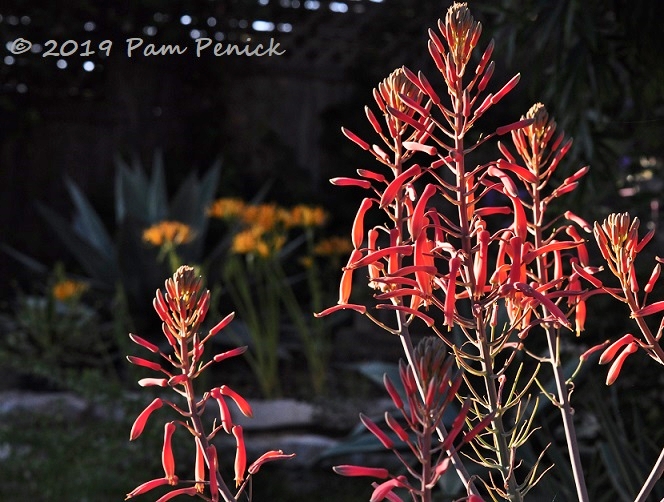
Aloe flowers
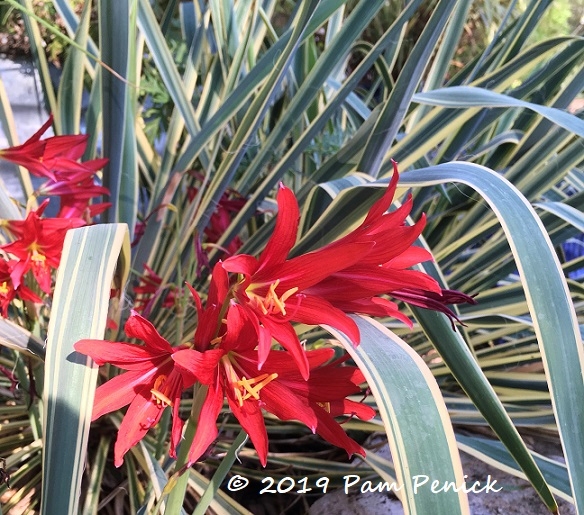
Most of the oxblood lilies (Rhodophiala bifida) must push up through the leaves of other plants, poor things. But they do it! These grow amid the strappy leaves of ‘Bright Edge’ yucca, whose yellow margins color-coordinate with the lilies’ stamens.
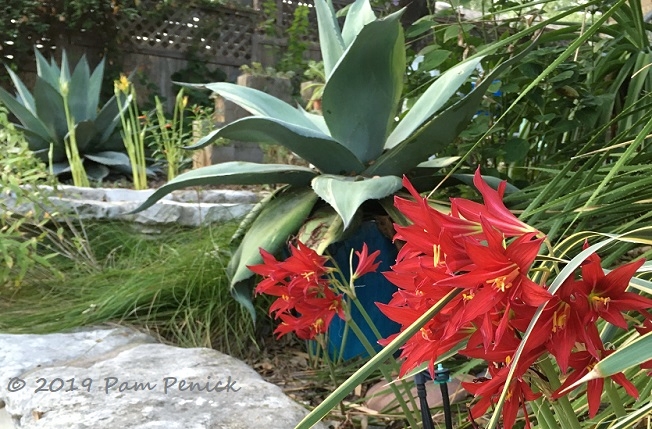
The same cluster as seen from the other side, with a potted whale’s tongue agave (Agave ovatifolia) behind them.
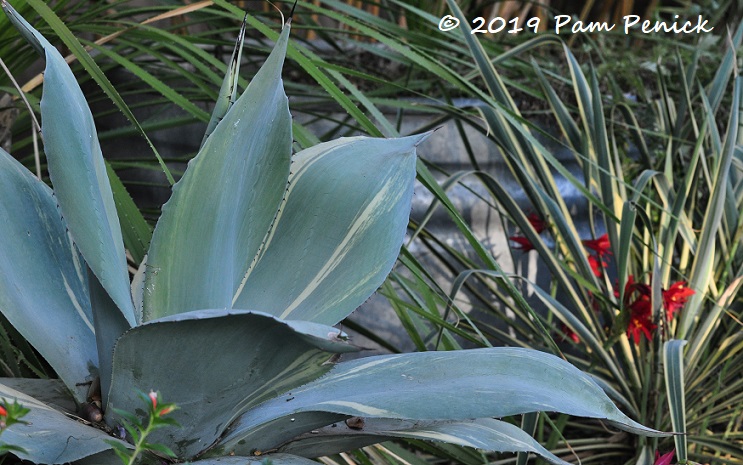
That whale’s tongue agave was a parting gift from blogger Jennifer Brown, who moved to New Zealand a year ago. She treasured it for the moonshine-yellow variegation on its powder-blue leaves and wanted it to go to a good home. I’m enjoying it in the pot for now but will soon have to find a spot in the garden where it can spread its flukes. Unless Jennifer returns to Texas and wants her baby back, of course.
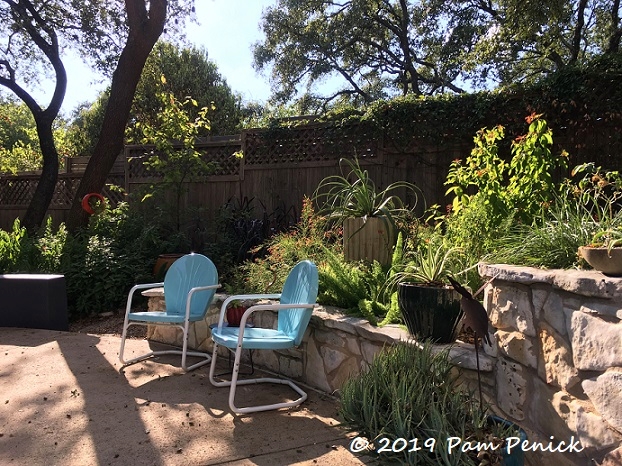
Late afternoon sunlight filtering through the live oaks
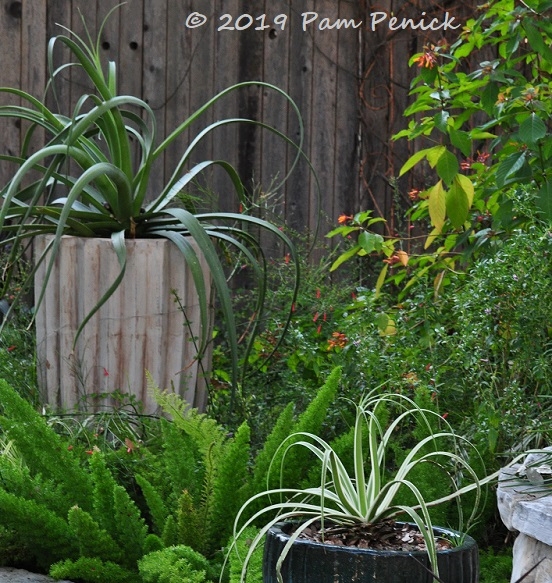
Here are two more agaves I plant throughout my shady garden: squid agave (Agave bracteosa) and its variegated form, A. bracteosa ‘Monterrey Frost’. I adore those curvy, tentacle-like leaves.
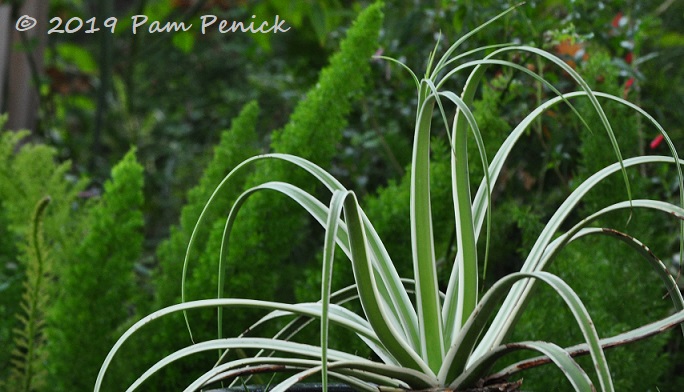
‘Monterrey Frost’ squid agave is troubled with rusty spots on its lower leaves, which get so bad I occasionally have to prune them off. But it seems healthy otherwise. Does anyone else have this problem?
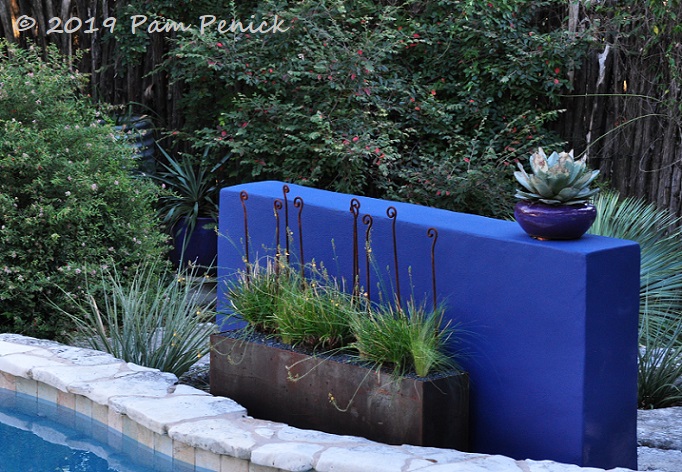
The blue wall surrounded and softened by bulbine, Mexican feathergrass, hesperaloe, dwarf Barbados cherry, and loropetalum. An artichoke agave (Agave parryi var. truncata) sits atop the wall and was, until recently, perfectly shaped and beautiful. And then we had our swimming pool refinished, and I asked the guys to throw a tarp over the wall and plants to protect them from the sandblasting, and they chose black plastic on a 100-degree day. In a matter of hours, the poor artichoke agave was solarized under the black plastic, its leaf tips bleached. The pool, however, looks fantastic, so it was a worthy sacrifice? (Sorry, agave!)
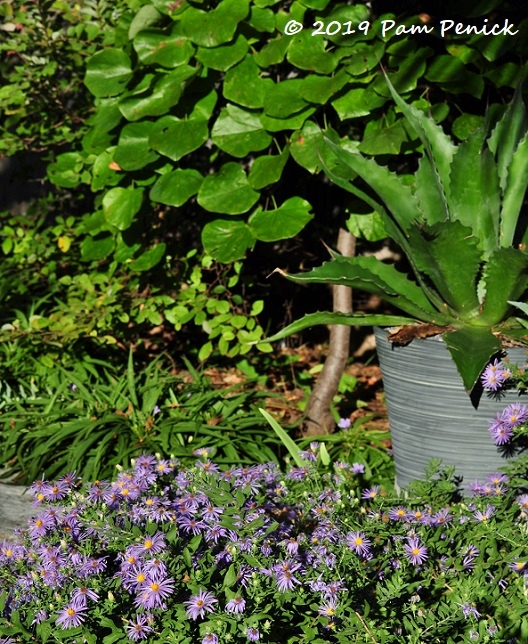
Fall aster (Aster oblongifolius), one of my favorite native plants for autumn color, seen here with ‘Green Goblet’ agave, weeping Texas redbud, and ‘Katie’ ruellia.
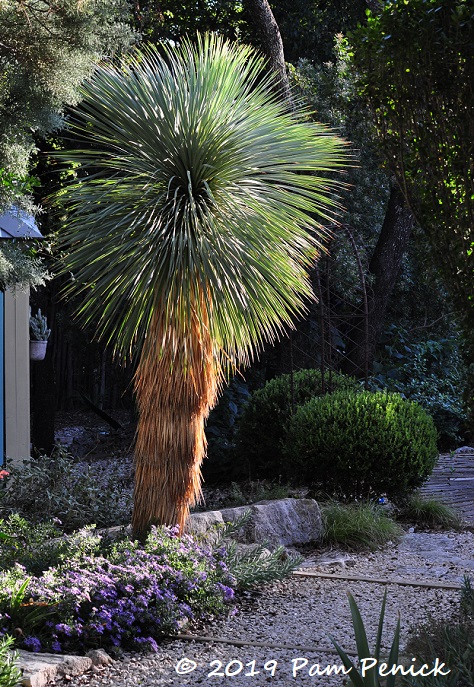
Another view of the fall aster, which makes a purple carpet beneath a majestic Yucca rostrata ‘Sapphire Skies’. The yucca’s spherical bristle-head echoes the round ‘Winter Gem’ boxwoods of the pond garden. Aside from its absolute indifference to heat or cold, I love this yucca for its undulating, grassy movement in the breeze and its cooling powder-blue color.
__________________________
Digging Deeper
Come learn about gardening and design at Garden Spark! I organize in-person talks by inspiring designers, landscape architects, authors, and gardeners a few times a year in Austin. These are limited-attendance events that sell out quickly, so join the Garden Spark email list to be notified in advance; simply click this link and ask to be added. Season 8 kicks off in fall 2024. Stay tuned for more info!
All material © 2025 by Pam Penick for Digging. Unauthorized reproduction prohibited.


Pam, Isn’t the squid agave the one that doesn’t die after it blooms?
I thought all agaves did, Pam. If the squid is an exception, I haven’t yet had an opportunity to see firsthand.
After you said the squid agave would die, I decided to check it out because I had read that there was an exception. The A. bracteosa doesn’t die, also doesn’t bloom every year, though. I was thinking it must be true for the larger Octopus, but no. Even though it looks the same that one will die. So don’t throw your bracteosa away if it flowers.
That’s great to know! Thanks for sharing.
As refreshing and welcome as last week’s rain! Thank you for sharing your lovely garden.
Aw, thanks, Cynthia. Here’s to more rain tonight (fingers crossed!).
Your garden is looking “second spring” fresh Pam. I do have the same issue with my ‘Monterrey Frost’ … good to know it’s not just mine!
Isn’t it frustrating? Monterrey Frost is such a gorgeous plant otherwise. I wonder what can be done to prevent that rusting on the leaves.
You caught ‘Monterey Frost’ in a pristine and lovely moment for this post! The variegation helps emphasize the length and skinny-ness of the foliage, and makes it stand out from most any background. Gorgeous.
Ooops: *Monterrey*.
Thanks, Nell. It’s a lovely plant. I just wish I knew why it’s getting rust.
Your first photo is stunning, Pam. Has me drooling and wishing I had something similar in my garden. And the garden as a whole is looking very fine indeed!
Thanks, Pat!
You do have a lot of blooms. I think those aloe blooms are so cool. Your poor agave that got burned up on the edges. Do you think it will recover?? You gotta keep an eye on those workers. They don’t mean to be destructive but sure enough they do muck up things. Happy second spring.
I hope it will recover, but it will take time for new leaves to grow large enough to obscure the damage, I think. C’est la vie! Honestly I feel lucky that that was the only thing damaged during a week of contractors tearing things up in the pool.
Ahh, everything looks so happy and refreshed! And beautiful, as always.
Thanks, Maggie. Rain and cooler temps make a huge difference for the plants and my own mental state.
Your garden sure responds well to a drop in temperature, Pam! Despite the return of temperatures in the 85-90F range here, my own Barleria (B. obtusa) also just started blooming – I wish I had a pretty cobalt blue wall to back mine. Your squid agave looks fabulous too.
Philippine violet is one of my faves for fall. And yes, a cobalt wall makes everything better. 😉
Hi Pam! I’m an Austinite who’s new to gardening, and I planted several native plants in this spring. I read your article about protecting plants from a Texas deep freeze, but two of my plants weren’t mentioned: powis castle artemisia and Mexican heather. Can you advise whether they should be covered when it’s below freezing? Thanks!
Hi Kirsten, and congrats to you on your new plants! Neither ‘Powis Castle’ artemisia nor Mexican heather are native to Texas, although both do well in our hot, humid summers. The artemisia will look sad and droopy after a hard freeze, but it should return just fine in the spring, so I wouldn’t bother covering it. Let the droopy, freeze-bitten foliage remain through the winter to protect the roots below. Around Valentine’s Day you can cut it back hard to promote new growth.
Mexican heather is harder to keep alive in winter. I had one that lived through several winters in my garden, only to eventually succumb to a hard freeze. So I would treat it as an annual. If you have it growing in a warm spot close to your house or a wall, you can cover it during a hard freeze to try to save it. Otherwise I’d probably just let nature take its course and replant in spring if you wish. For a winter-hardy substitute you might try catmint or our native purple skullcap.
Thank you for the information and the tip about purple skullcap. I’ll try that as a replacement if I lose the Mexican heather. I’ve found your blog incredibly helpful in planning my garden, especially being new to all of this. Thank you for your thoughtful and helpful posts!
You’re welcome, Kirsten. Plant that skullcap in gravelly soil, don’t over-mulch it (gravel mulch is good), and give it full sun. And thanks for letting me know you find Digging useful as a new gardener. Yay!
Hi Pam, a follow-up question about my Powis Castle artemisia. I planted it in April last year and didn’t cut it back after the winter. It’s gotten quite leggy and is growing over top of my other plants in the flowerbed (Mexican Heather and foxtail ferns). I tried cutting the artemisia back this summer, but seemed to have made the leggy-ness worse! Should I cut my losses and remove the artemisia? I love the color and texture but not the size. Is there a replacement you’d recommend? I’d like something that only takes up about 2’ of space. Thanks so much!
To answer your artemisia question, yeah, it probably wants to be larger than two feet, although with a February cutback you might be able to keep it in scale. Nothing is coming to mind right now as a substitute for the color, texture, and size you want. There’s lamb’s ear, but it needs more shade than sun in our climate. In which case, it might be worth experimenting with pruning to see if you can keep the artemisia.
Ok thanks Pam!